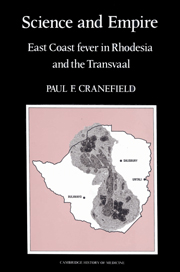Book contents
- Frontmatter
- Contents
- List of illustrations
- Preface
- Acknowledgments
- 1 Prologue
- 2 The places and the players
- 3 A new disease?
- 4 The search for an expert
- 5 Robert Koch in Bulawayo
- 6 Joseph Chamberlain
- 7 Arnold Theiler, Charles Lounsbury and Duncan Hutcheon
- 8 The fight against East Coast fever
- 9 The African-owned cattle in Rhodesia
- 10 Two more parasites and another new disease
- 11 What is East Coast fever?
- 12 Epilogue
- Notes and references
- Index
8 - The fight against East Coast fever
Published online by Cambridge University Press: 19 January 2010
- Frontmatter
- Contents
- List of illustrations
- Preface
- Acknowledgments
- 1 Prologue
- 2 The places and the players
- 3 A new disease?
- 4 The search for an expert
- 5 Robert Koch in Bulawayo
- 6 Joseph Chamberlain
- 7 Arnold Theiler, Charles Lounsbury and Duncan Hutcheon
- 8 The fight against East Coast fever
- 9 The African-owned cattle in Rhodesia
- 10 Two more parasites and another new disease
- 11 What is East Coast fever?
- 12 Epilogue
- Notes and references
- Index
Summary
Throughout most of 1902, Charles Gray and the Rhodesian government took the position that the new disease was only a form of redwater and that cattle that had once been immune to redwater had lost their immunity and were now liable to reinfection. As Orpen said on April 17, 1902, since a general infection of Rhodesia by redwater had taken place long ago, the disease would break out again, wherever local conditions were favorable. Thus no legislation could check its spread. On May 22, Robertson reported that since “all Rhodesia is infected with ticks, I do not think any cordon or barrier can be of any avail.” In the same report Gray attacked those who “lay all blame for the spread of the disease at the door of the Agricultural Department without taking into consideration the fact that the apparent epidemic nature of the disease may be the natural cumulative result of long established infection.” On May 12, 1902, Gray had even written to Orpen that the cordon between Salisbury and Bulawayo “was instituted temporarily to allay public unrest in Bulawayo, fomented by those who declined to accept… that the disease was redwater.” Thus, Gray said, as soon as Robertson had confirmed his views, the cordon was withdrawn.
The disease was new, at least in Rhodesia, and it was spread by a tick, the brown tick.
- Type
- Chapter
- Information
- Science and EmpireEast Coast Fever in Rhodesia and the Transvaal, pp. 181 - 222Publisher: Cambridge University PressPrint publication year: 1991



